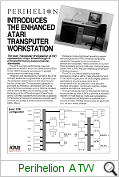|

The Atari ABAQ* as it was originally called, was launched in 1988, and
was a project born from what eventually became the UK research office of Atari.
That company was called Perihelion Hardware and was headed by Richard
Miller (who would later become head of Atari R&D). Perihelion
Software headed by Tim King, would develop the software operating system
called Helios. * - ABAQ was changed to ATW due to a trademark dispute.
Transputer technology had been
advanced through Inmos (now part of SG- Thompson), a company largely
responsible for the commercial success of the T-400 and T-800.
Transputers had been largely unsuccessful commercially, mostly due to
the price and the lack of any mainstream support for the product.
But there was no doubt of their power, which lay not within any one
Transputer, but when they were "farmed" to enable true parallel
processing. In addition, many machines could be networked for
"cluster" type computing.

Why did Atari get involved with this
technology? The company was looking to develop a more powerful
computing tool, and at this time their ST system was being tweaked on
the drawing board. Initial reports mentioned development of an "ST
Transputer" or add-on board for the the current ST range, but this would
be just rumour, the fact was Atari had been developing a very niche
product in conjunction with Perihelion, another UK based company.
With any rumour, there is always some fact, and the ST part of the
project would become the controller-board for the new Abaq, later
renamed the ATW-800 or Atari Transputer Workstation.
Atari had also been discussing the product
with Universities and other organisations who required low-cost,
high-powered computing. In fact, of the 250 or so units finally
assembled, nearly all of them would end up with Kodak, who utilised the
systems for internal photographic-processing requirements.


Eventually, the system yielded little
commercial success, and with more advanced CPU's coming on-stream, such
as the Motorola 68030 (at one-third the price of a single T-800), Atari
soon cancelled any further development. Atari did use the
knowledge of the architecture later on, through the RISC-based design of
their gaming system Panther utilising a version of the ATW "Blossom"
video system.
|